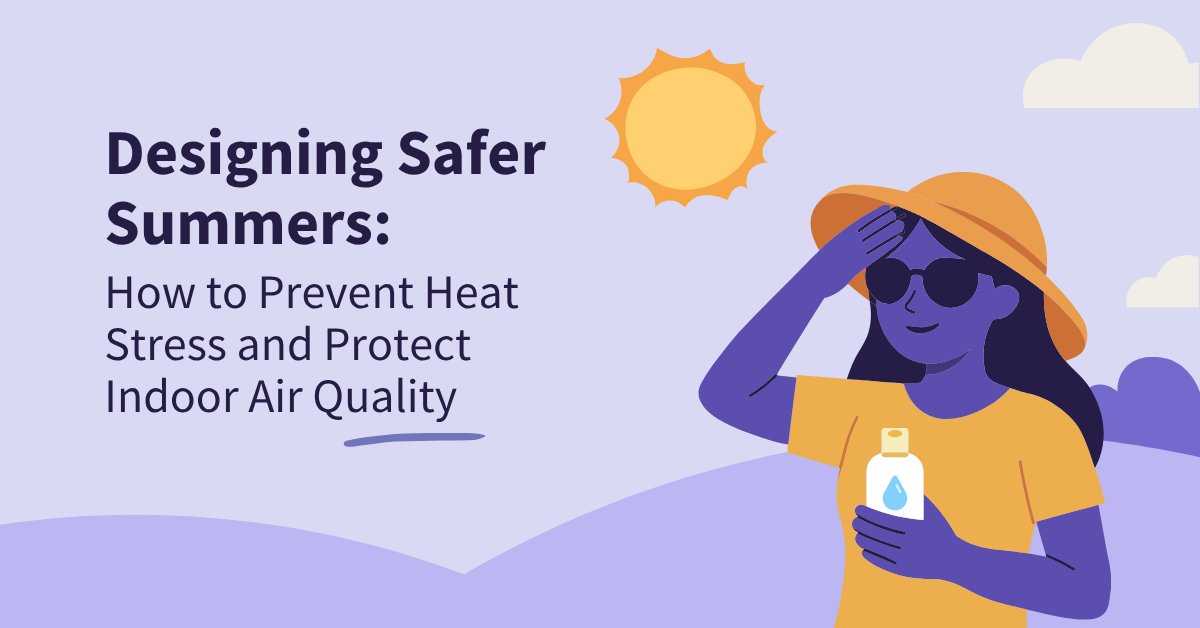Designing Safer Summers: How to Prevent Heat Stress and Protect Indoor Air Quality

As summer temperatures soar and air quality fluctuates, communities face a dual challenge: keeping people safe from extreme heat and ensuring the air they breathe indoors stays clean. These are not just comfort concerns, they’re critical public health issues.
Whether you’re managing a workplace, school, camp, or community space, understanding heat stress prevention and indoor air quality (IAQ) is key to creating healthier environments this season.
Here’s what you need to know, and what you can do to protect your people.
Why Heat Stress Is a Growing Threat
Extreme heat is more than uncomfortable, it’s dangerous. Heat stress occurs when the body cannot cool itself effectively, leading to symptoms ranging from dehydration to life-threatening heat stroke.
According to the CDC, heat-related illnesses kill more people in the U.S. than hurricanes, floods, and tornadoes combined. Vulnerable groups like children, older adults, outdoor workers, and those with chronic illnesses are at especially high risk.
But workplaces, camps, and schools are not immune. Even indoors, poor ventilation and high humidity can exacerbate the problem.
The Hidden Risk of Indoor Air Quality in Summer
When heatwaves and air quality alerts hit, people naturally retreat indoors. But this can create its own set of challenges:
- Stale air and pollutants: Without proper ventilation, indoor spaces can trap heat, humidity, and airborne particles.
- Infectious disease spread: Crowded indoor areas with poor airflow increase the risk of respiratory infections.
- Energy-saving measures backfiring: Closing windows and reducing HVAC use to save energy may worsen indoor air quality.
A study by the EPA shows indoor air can be 2–5 times more polluted than outdoor air, especially during summer months when ventilation is limited.
5 Summer Safety Tips to Prevent Heat Stress and Improve Indoor Air
Whether you’re a camp leader, school administrator, or workplace manager, these practical actions can help protect your people:
1. Make Hydration a Priority
- Set up water stations in convenient locations.
- Encourage regular drinking, don’t wait for signs of thirst.
- Offer electrolyte drinks during extreme heat to replenish lost minerals.
2. Adjust Schedules for Cooler Hours
- Plan outdoor activities in the early morning or late afternoon.
- Avoid strenuous tasks during peak heat (10 AM – 4 PM).
- Create shaded areas for rest breaks.
3. Improve Indoor Air Circulation
- Keep HVAC systems well-maintained and change filters regularly.
- Use portable air purifiers with HEPA filters in high-traffic areas.
- Open windows when outdoor air quality allows to promote fresh airflow.
4. Reduce Indoor Crowding
- Stagger schedules to avoid overcrowding in lunchrooms or gyms.
- Monitor CO₂ levels in indoor spaces as a proxy for ventilation quality.
- Encourage mask use in poorly ventilated areas during disease outbreaks.
5. Educate and Empower Your Team
- Train staff to recognize early signs of heat stress: dizziness, heavy sweating, nausea.
- Share air quality apps and heat alert systems for real-time updates.
- Develop response plans for heat-related illnesses and poor air quality days.
Community-Wide Benefits of Heat Stress Prevention
Preventing heat stress isn’t just about individual health, it builds community resilience. Safer workplaces keep employees productive, schools protect students and staff, and camps maintain the wellbeing of children and counselors alike.
Clean indoor air also has lasting benefits: reduced absenteeism, fewer respiratory issues, and greater comfort for everyone.
Building a Safer Tomorrow Starts Today
Summer’s risks are complex, but with the right strategies, they’re manageable. By addressing both heat stress prevention and indoor air quality, your organization can create healthier spaces where people can work, learn, and play safely, even in the hottest months.
Ready to lead the way? Join Commit to C.A.R.E. and gain access to science-backed resources, expert guidance, and a network of organizations dedicated to community health.
